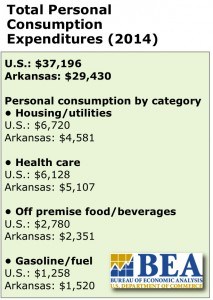Arkansas consumer spending growth trails most of the U.S., healthcare spending outpaces housing
by December 1, 2015 3:00 pm 299 views

It’s been more than five years since the recession of 2008 and 2009 officially ended, but consumer spending patterns across Arkansas remain muted compared to the rest of the nation.
Total personal consumption expenditures in Arkansas rose 2.8% last year to $87.3 million. The growth pace rose from 2.6% in 2013, but personal spending across the Natural State is still one of the slower growth paces in the nation, according to Tuesday’s (Dec. 1) report from the U.S. Department of Commerce Bureau of Economic Analysis.
On a per-capita basis Arkansas ranks near the bottom when it comes to per person consumption spending. The report found Arkansas’ per capita personal consumption expenditures for 2014 to be $29,430, only Mississippi was lower at $29,386. This compared to a national per capita spending rate of $37,196. Among the states, Massachusetts had the highest per person spending rate at $48,202. The District of Columbia, not considered a state, set the bar the highest at $55,141.
All U.S. consumers increased their spending by 4.2% from 2013 to 2014, and large states like Texas grew personal consumption spending by 5.7% in the year-over-year period. Other areas enjoying a boom from fracking like North Dakota remained the fastest growing with personal consumption spending rising 7.4%, although it’s at a lower overall level of $35.3 million, according to the report.
Despite somewhat stagnant wages consumers found a way to spend more when it comes to housing, utilities and healthcare, followed by services and nondurable goods. The categories accounted for about half the growth in personal consumption spending by state. But Arkansas consumers still spent less in many categories than consumers in other states.

Healthcare spending was the only category that grew more than housing last year for Arkansas residents. Spending on healthcare-related costs increased 3.4% to $5,107 per person last year. This compared to $6,128 per person nationwide, while Maryland had the highest healthcare cost expenditures at $11,358 per person last year.
Together housing and healthcare cost increases attributed nearly half of the overall annual spending growth by Arkansas residents last year. Arkansas consumers also spent 5% more on their vehicles, 2.7% more eating out and 6.2% more on recreation and accommodation services combined, according to the report.
Transportation spending rose 4% but Arkansas had the largest decline (-8.3%) in gasoline and energy goods spending than any other state last year. The nation as a whole saw a 2.9% dip in energy goods and gasoline spending compared to 2013.
Tyson Foods CEO Donnie Smith recently told the media that consumers are taking their gasoline savings and likely eating out more which is pushing fast casual and quick serve restaurant sales higher than a year ago. He said consumers initially were saving more of that money, but as fuel prices stayed low consumers loosened up the purse strings to enjoy more entertainment which includes eating out.
Arkansas consumers remain somewhat conservative with their spending habits according to a recent report from Arvest Bank and the University of Arkansas. That shows in the BEA report. Durable goods spending rose 1.3% last year in Arkansas, while home furnishing expenditures were 1.9% higher than in 2013. That compares to a nationwide average of 1.7% and 2.8%, respectively.
However, recent tax reports indicate that Arkansans are spending more in 2015.
Sales and use tax revenue during the first four fiscal months (July 2015-October 2015) months totaled $789.7 million, up 6.5% compared to the same period in 2014. Sales and use tax revenue during October was $193.6 million, up 5.2% over October 2014 and 3.2% above the budget estimate.
“The results reflect continued growth in underlying economic indicators for consumption, and now totals seven consecutive months of elevated growth in collections,” Shelnutt noted in the report.
John Shelnutt, director of economic analysis and tax research for the Arkansas Department of Finance & Administration, said in the October report.
